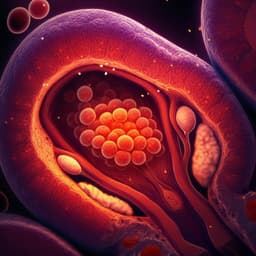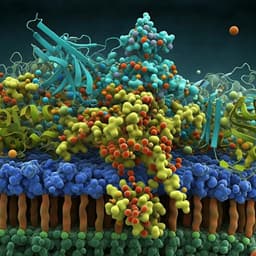
Medicine and Health
Targeting senescence induced by age or chemotherapy with a polyphenol-rich natural extract improves longevity and healthspan in mice
S. Zumerle, M. Sarill, et al.
Discover how *Salvia haenkei* extract (Haenkenium, HK) has been shown to extend lifespan and healthspan in aged mice, while combating age-related inflammation and senescence. This groundbreaking research, led by a team at the Veneto Institute of Molecular Medicine, unveils the promising effects of luteolin in improving muscle strength and fur thickness. Dive into the findings that may change the landscape of aging research!
~3 min • Beginner • English
Introduction
The aging population in high-income countries is associated with increased prevalence of age-related diseases and growing societal and economic burden. Rather than treating single pathologies, targeting fundamental mechanisms of aging to improve healthspan is a promising strategy. Cellular senescence—stable cell-cycle arrest accompanied by expression of inhibitors such as p16INK4a and SASP secretion—accumulates with age and contributes to tissue degeneration. Removing or modulating senescent cells improves healthspan and lifespan in animal models. Botanical extracts contain polyphenols, flavonoids, and terpenoids with reported anti-aging properties via mechanisms such as Nrf2 activation, mitophagy, sirtuin induction, and mTOR inhibition. Prior high-throughput screening identified a Salvia haenkei (SH) extract with senomorphic effects in vitro, reducing SA-β-Gal positivity and modulating factors linked to skin aging and oxidative stress. The present study tests in vivo whether a standardized SH extract (Haenkenium, HK) can extend healthspan and lifespan in naturally aged mice and mitigate therapy-induced senescence, and investigates mechanisms, including the role of the flavonoid luteolin and its potential disruption of the p16–CDK6 interaction.
Literature Review
Research has shown that selective removal of senescent cells improves lifespan and function in aged animals. Traditional botanical medicines and plant-derived nutrients (polyphenols, flavonoids, terpenoids) exhibit anti-aging properties, acting through antioxidant defense (Nrf2), mitophagy, sirtuins, and nutrient-sensing pathways (mTOR/protein translation). Previous work identified a Salvia haenkei extract with senomorphic activity, enhancing wound healing and reducing ROS while upregulating barrier and longevity-associated factors (occludin, filaggrin, SIRT1) in vitro. Flavonoids such as fisetin and procyanidin C1 have senotherapeutic effects and can extend lifespan in mice. Luteolin, a common dietary flavonoid, has documented antioxidant, anti-inflammatory, and anti-senescence actions via SIRT1/SIRT6, AMPK/mTOR, and NF-κB modulation, and has been reported to attenuate doxorubicin-induced cardiotoxicity. However, specific mechanisms by which SH/HK might modulate senescence in vivo and identification of active constituents within HK required further study.
Methodology
In vivo aging study: C57BL/6 mice (both sexes) housed across three facilities were treated with HK in drinking water at 0.5 mg kg−1 day−1 starting at 20 months of age until natural death for lifespan analysis, or for 4 months for phenotypic and tissue analyses. Survival was compared by log-rank tests; healthspan was assessed weekly using a Physical Appearance Score (fur status, kyphosis, cataracts, palpable tumors). Body composition (EchoMRI), insulin and glucose tolerance tests, water intake, and hematology were measured.
Tissue phenotyping: Skin (H&E; hair follicle diameter), bone (microCT for bone tissue % and BMD), cartilage (H&E and Safranin for proteoglycan loss; OARSI scoring), muscle strength (forelimb grip), tibialis anterior myofiber cross-sectional area (dystrophin IF), and kidneys (H&E for glomeruli diameter; picro-sirius red for fibrosis; RT-qPCR of Col1a1, Col3a1, Fn1) were analyzed. Serum markers (e.g., Cystatin C) and proteome profiler cytokine arrays were performed.
Transcriptomics: Bulk RNA-seq on gastrocnemius muscle from young (4 mo), old untreated (24 mo), and old HK-treated (24 mo, 4 months treatment). DESeq2 identified aging DEGs; custom gene sets (MOUSE_ADULT_UP/DN) were used in GSEA (camera) to assess reversal by HK. Additional curated aging-related pathways (nutrient sensing, proteostasis, stem-cell maintenance, mitochondrial biogenesis, telomere length, genomic instability, epigenetic changes) were assessed. Western blots evaluated p-eIF2α, p-4EBP1, p-S6, LC3A/B, PGC1α in kidneys.
Senescence markers: RT-qPCR in muscle for Cdkn1a and Tp53; IHC for p16, p27, γH2AX (skin), p16, p27, 53BP1 (kidney), and p27 (lung) in young, old untreated, and old HK-treated mice.
Therapy-induced senescence (TIS) models: p16Luc reporter mice received a single intraperitoneal dose of doxorubicin (20 mg kg−1). HK (0.5 mg kg−1) was administered by oral gavage daily starting 3 days prior to Doxo. Luminescence was measured 7 days post-Doxo; body weight was monitored. In vitro human-induced cardiomyocytes (iCMs) were exposed to Doxo (0.2 μM, 3 h) to induce senescence (SenCMs), then treated with HK or luteolin and assessed by SA-β-Gal, RT-qPCR for p21, and multielectrode array recordings for QTcB interval over 6 days.
Phytochemical profiling and constituent testing: HK constituents were identified by UPLC-QTOF-MS (phenols/lignans, flavonoids, terpenes). A panel of compounds (flavonoids: isoquercetin, kaempferol, nobiletin, isorhamnetin, luteolin, luteolin-7-O-glucuronide; lignan: pinoresinol; phenolic acids: rosmarinic acid, 3,4-dicaffeoylquinic acid) was tested at 1 μM for ability to reduce SA-β-Gal after UV-B in IMR90 fibroblasts versus HK (10 μg ml−1). Dose-response for luteolin (0.01–2.5 μM) was assessed in UV-B IMR90, and Doxo-induced WI38 fibroblasts and iCMs; HK-2 renal cells with albumin-induced senescence were also tested. Pharmacokinetics: mice received HK 0.5 mg kg−1 by gavage; plasma luteolin was measured at 0, 15, 60, 360 min. In vivo luteolin: mice pretreated with luteolin (0.5 mg kg−1) 3 days before Doxo (10 mg kg−1), with SA-β-Gal assessed in kidney at day 7.
Mechanism assays: In silico docking (ChEMBL/SIB/SEA; GLIDE) predicted luteolin binding to CDK6. Surface plasmon resonance (SPR) measured p16-CDK6 interaction with/without luteolin or fisetin. In situ proximity ligation assay (PLA) in WI38 cells assessed p16-CDK6 interaction after UV-B with luteolin pretreatment. Western blot measured p16, CDK6, Cyclin D1 after UV-B. Rb phosphorylation at CDK6-targeted residues was measured in IMR90 after serum starvation and release with or without HK or luteolin. Statistical analyses included t-tests, one-way/two-way ANOVAs with multiple-comparisons corrections, Kruskal–Wallis, and log-rank for survival.
Key Findings
Longevity and healthspan: HK (0.5 mg kg−1 day−1) increased median lifespan of aged C57BL/6 mice from 28.0 to 32.25 months (+15%; n=37 control, n=48 treated; P=0.0045). Both sexes benefited: females 28.0→31.5 months (+13%; P=0.0337), males 28.0→32.8 months (+17%; P=0.0494). The effect was consistent across three facilities and without observed toxicity or changes in hematology, glucose homeostasis, body composition, or water intake.
Healthspan metrics: HK improved Physical Appearance Score (reduced kyphosis, tumor development, and improved fur). Skin H&E showed larger hair follicle diameter in treated 24-month-old mice. Bones: increased femoral bone tissue % and bone mineral density; joints: reduced proteoglycan loss and lower OARSI scores. Muscle: old mice had reduced grip strength versus young; HK significantly ameliorated grip strength decline; tibialis myofiber CSA showed a trend toward improvement. Kidney: reduced glomeruli diameter toward youthful levels; significantly reduced fibrosis by PSR staining and lower mRNA levels of Col1a1, Col3a1, Fn1. Serum Cystatin C decreased. Proteome profiling indicated reversal of age-elevated Pentraxin-2/SAP and Lipocalin-2/NGAL.
Molecular pathways: Gastrocnemius RNA-seq revealed an aging signature enriched for inflammation, immune activation, and senescence/SASP (e.g., SAUL_SEN_MAYO). HK significantly downregulated the aging-upregulated gene cluster and SAUL_SEN_MAYO set. Other hallmarks (nutrient sensing, proteostasis, stem-cell maintenance, mitochondrial biogenesis, telomere length, genomic instability, epigenetic changes) were not significantly altered by HK; western blots corroborated no changes in p-eIF2α, p-4EBP1, p-S6, LC3A/B, PGC1α.
Senescence markers: In muscle, HK reduced Cdkn1a (p21) and Tp53 mRNA. IHC showed age-elevated p16, p27, γH2AX in skin and p16, p27, 53BP1 in kidney were attenuated by HK; lung p27 was also reduced.
Chemotherapy-induced senescence and cardiotoxicity: In p16Luc mice, a single Doxo injection increased luminescence (senescence); 3-day HK pretreatment reduced p16 signal and mitigated weight loss. In iCMs, HK attenuated Doxo-induced SA-β-Gal and reduced p21 mRNA. Doxo prolonged QTcB; HK rescued QTcB toward baseline without affecting control iCM electrophysiology.
Active constituent and mechanism: UPLC-QTOF-MS identified phenols/lignans, flavonoids, and terpenes; luteolin and luteolin-7-O-glucuronide were prominent. At 1 μM, luteolin, luteolin-7-O-glucuronide, and 3,4-dicaffeoylquinic acid reduced UV-B-induced SA-β-Gal in IMR90; luteolin was most prevalent among flavonoid aglycones (~1.33% w/w with derivatives). Luteolin dose-dependently reduced SA-β-Gal in UV-B IMR90 and Doxo-induced WI38 and iCMs; HK-2 albumin-induced senescence showed a non-significant trend. Pharmacokinetics detected plasma luteolin with Cmax ~55 ng ml−1 at 15 min after HK gavage. In vivo luteolin (0.5 mg kg−1) pretreatment reduced Doxo-induced kidney SA-β-Gal. Docking predicted luteolin binding to CDK6; SPR showed luteolin disrupted p16–CDK6 interaction, whereas fisetin did not at tested conditions. PLA confirmed luteolin reduced p16–CDK6 interaction in UV-B WI38 without altering p16 or CDK6 levels. HK and luteolin increased CDK6-dependent Rb phosphorylation after serum refeeding, supporting functional disruption of p16–CDK6.
Discussion
Daily low-dose HK extended lifespan and improved multiple healthspan parameters in aged mice without observable toxicity, even when initiated at 20 months of age. Transcriptomic and histological data indicate HK prominently modulates the senescence/SASP axis and age-related inflammation rather than broadly altering other canonical hallmarks of aging. HK also protected against chemotherapy-induced systemic senescence and cardiotoxicity, rescuing electrophysiological dysfunction in iCMs. Phytochemical profiling and functional assays identified luteolin as an active senomorphic component of HK. Mechanistically, luteolin disrupts the p16–CDK6 interaction, attenuating senescence signaling and facilitating CDK6 activity (Rb phosphorylation) under stress conditions. This mechanism provides a plausible molecular basis linking HK treatment to reduced senescence markers across tissues and improved organismal health. Given luteolin’s documented safety and anticancer properties, targeting the p16–CDK6 axis via dietary flavonoids may offer a practical approach to mitigate age- and therapy-related senescence. While HK’s broader biological effects (e.g., antioxidant activity, SIRT1 modulation) may also contribute, the convergence of transcriptomic, biochemical, and functional evidence underscores senescence modulation as a primary driver of benefit in this study.
Conclusion
A standardized Salvia haenkei extract (Haenkenium) administered at a low daily dose increased lifespan and improved healthspan in aged mice, reduced senescence markers across multiple tissues, and protected against doxorubicin-induced senescence and cardiotoxicity. HK’s phytocomplex contains luteolin, which displays senomorphic activity and disrupts the p16–CDK6 interaction, restoring CDK6 function and reducing senescence burden. The data support development of HK and luteolin-containing preparations as medical foods or therapeutics targeting age-related diseases and chemotherapy-associated toxicities. Future work should evaluate HK and purified luteolin in genetically heterogeneous mice, assess chronic chemotherapy models, delineate potential synergistic effects among HK constituents, and investigate impacts on other hallmarks of aging and additional tissues.
Limitations
The study focused on a single inbred mouse strain (C57BL/6), limiting generalizability; heterogeneous mouse populations may yield different outcomes. While senescence pathways were prominently modulated, other hallmarks of aging were not extensively altered in assessed tissues, and HK may act through additional mechanisms (e.g., oxidative stress reduction, SIRT1 upregulation) not fully explored in vivo. HK is a complex botanical extract; identification of luteolin as an active component does not exclude contributions from other constituents or synergistic effects, and in vivo causality for luteolin alone in lifespan extension remains to be established. The chemotherapy experiments used acute Doxo exposure; chronic regimens more reflective of clinical practice were not tested. Some scoring assessments were not blinded due to treatment administration logistics.
Related Publications
Explore these studies to deepen your understanding of the subject.







